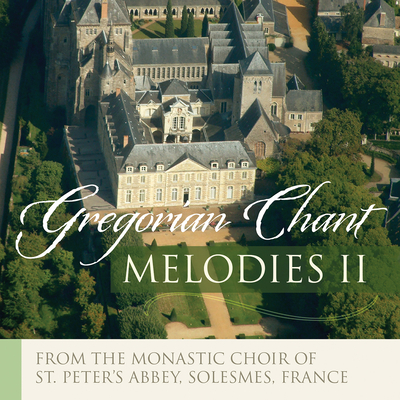
Gregorian Melodies II: Gregorian Chant
Description
Popular Gregorian chants from the Monks of Solesmes
Following the success of Gregorian Melodies, the monks of Solesmes have released Gregorian Melodies II. This volume contains more of the most popular chants including the Te Deum, Stabat Mater, and Ave Maria. There are also chants for the Liturgical Year from Advent to Pentecost, chants devoted to Our Lady and the Blessed Sacrament, and the Mass of the Angels. All of the Gregorian chants on the recording have a corresponding page number next to the listing that refers to the Liber Cantualis.
This is an ideal CD with which to become acquainted with Gregorian chant. The sensitive performances by Dom Richard Gagneë and the monks of Solesmes enhance the value of this series.
Mass of the Angels
Track 1-Sprinkling of Holy Water Asperges me
Track 2-Sprinkling, Eastertide Vidi aquam
Track 3-Kyrie VIII
Track 4-Gloria VIII
Track 5-Alleluia Tu es Petrus
Track 6-Sanctus VIII
Track 7-Agnus VIII
Advent
Track 8-Hymn Conditor alme siderum
Track 9-Alleluia Ostende nobis
Christmas
Track 10-Puer nobis in Bethlehem
Track 11-Alleluia Dominus dixit
The Passion
Track 12-Hymn Gloria laus
Track 13-Sequence Stabat Mater
Easter
Track 14-Alleluia Confitemini Domino
Pentecost
Track 15-Brief Responsory Spiritus Paraclitus
Benediction of the Holy Sacrament
Track 16-Chant of Exposition O salutaris
Track 17-Chant of Exposition Ecce panis
Track 18-Hymn Pange lingua gloriosi
Track 19-Psalm 116 Laudate Dominum
Chants to Our Lady
Track 20-Antiphon Alma Redemptoris
Track 21-Antiphon Ave Maria
Track 22-Antiphon Ave Regina caelorum
Track 23-Brief Responsory Ave Maria
Track 24-Hymn Ave maris stella
From the Office for the Departed
Track 25-Antiphon and Benedictus Ego sum
Thanksgiving
Track 26-Hymn Te Deum
Praise for Gregorian Melodies II: Gregorian Chant
“The most famous and ‘authentic’ recordings of Gregorian chant for generations have been those made by the Solesmes monks.” —The Boston Globe
“The music is utterly magnificent and the singing of this great choir is thrilling beyond words…it’s better to starve to this music than to live without it.” —Classic CD
“Supremely ethereal.” —USA Today
“Solesmes sets the standard for Gregorian chant performance.” —American Record Guide
"The success of Gregorian chant in the past century, and the centered richness of prayer it brings to all of us, is almost singularly due to the herculean efforts of the Benedictine Monks of Solesmes, France."
"Communicates a mood of mystery, timelessness, peace, beauty, and contemplation."
"The Monks of Solesmes ... use the most authentic manuscripts and ancient documents to recover the original melodies."
"The monks' chanting is living, strong, unvarnished."
"The chant is organic and text-based ... the singing is full and well-supported."
"There's something incredible fresh and new ... which is well worth your attention."
—New Liturgical Movement
"Beauty and immense spiritual power when sung by the Monastic Choir of St. Peter's Abbey, Solesmes, France"
"The music is exceptionally inviting, engaging listeners' ears with beauty and elevating their thoughts no matter what their spiritual or religious beliefs and doctrines may be."
"The beauties of Gregorian chant...encourage inward looking, contemplation, thoughtfulness, a kind of separation from mundane affairs ... Gregorian chant resonates."
"The sensitive, careful, beautifully measured performances here can be used as an entry point to an earlier time."
—TransCentury Communications
"The program of the two discs (Gregorian Melodies I and II) are similar, offering alternate settings on each disc of the sprinkling of water, the Ordinary of the Mass (two cycles on the first disc, another on the second), Benediction hymns, and the most familiar pieces marking the liturgical year. The final antiphons of Our Lady are sung in the simple (more modern) tone, two on each disc. Sung so superbly as they are here, these two discs are exactly what are needed for those who long to hear the familiar chants again." — Fanfare
"Here we have clean, sensibly phrased performances of 29 Gregorian melodies taken from the Liber Cantualis, each with its corresponding number in the Liber and respective place in the service and/or liturgical calendar. This recording contributes an intriguing strain to the debate over historical performance. The Monastic Choir of St. Peter's Abbey in Solesmes sings in a different dimension. Their tone is essentially clean, and their intonation impeccable. The result is a focused, calm, and consistent performance. They sing in a historically authentic mindset. This is a wholly satisfying offering, and a fine supplement to the body of recorded Gregorian chant." —Early Music America

